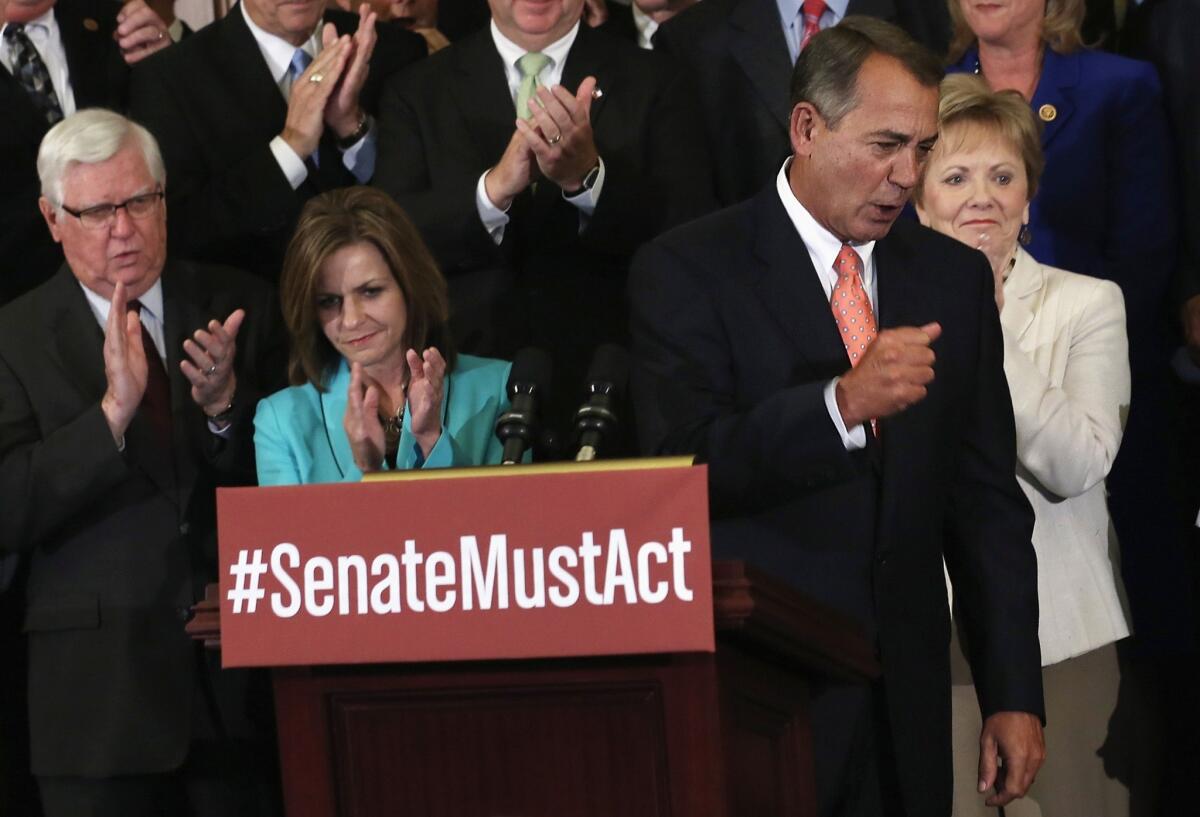‘Defund Obamacare’ just a sideshow to Washington’s real budget fight

For the fourth consecutive year, lawmakers have failed to pass any of the 12 annual spending bills that fund the federal government and so must pass a stopgap measure (called a continuing resolution, or CR) to keep Washington’s lights on past Sept. 30. This time the CR has become enmeshed in a partisan battle over the 2010 healthcare law, with Republicans pushing to “defund Obamacare” and Democrats saying they won’t do anything of the kind.
The drama over Obamacare, however, has obscured what the two parties are really fighting over: total discretionary spending in the coming fiscal year, and how that’s divided between defense and non-defense programs. While not as sexy as the long-running and bitter battle over the Patient Protection and Affordable Care Act, it’s a significant one, considering that discretionary spending accounts for about a third of all federal outlays. And it’s conceivable that the GOP’s long-shot attempt to defund Obamacare could reduce its leverage over total spending.
The GOP-controlled House and the Democrat-controlled Senate passed dueling budget resolutions in March that set very different spending levels for fiscal 2014. The House’s budget called for deeper cuts in projected spending than Congress agreed to in 2011, proposing to eliminate annual deficits within 10 years without raising taxes. The Senate laid out a much less ambitious plan for deficit reduction, and proposed to replace about half of the cuts agreed to in 2011 -- the automatic, across-the-board sequester reductions -- with a combination of tax increases and new restraints on entitlements.
The prudent thing to do at that point would have been to hash out a budget that could pass both chambers. But House Republicans refused to go to conference, reasoning that they could get a better deal if they waited until the end of the current fiscal year approached and a government shutdown loomed.
The appropriations committees in each chamber went ahead and developed spending bills for fiscal 2014, but there was no chance any of them could become law unless and until there was an agreement on total spending. And there apparently have been no negotiations on that issue between House and Senate leaders, aside from some informal talks.
Which brings us to Friday. The House passed the Republican-penned CR (HJ Res 59) on a near-party-line vote; it would keep federal agencies operating for about 2 1/2 months. According to the Congressional Budget Office, the funding in the bill equates to $986 billion in discretionary spending if sustained over a full year. That’s about $19 billion more than would be allowed under the 2011 law’s sequester.
Significantly, though, the House CR would hold non-defense spending below the sequester level, while pushing defense spending $20 billion above it (on an annualized basis). That’s despite the fact that House Appropriations Committee Chairman Hal Rogers (R-Ky.) has complained that the cuts to non-defense programs are unrealistically deep.
Meanwhile, Senate appropriators have counted on having $91 billion more to spend in fiscal 2014 than the House proposed, thanks to the assumed (but not yet actual) repeal of the sequester cuts. That’s about 10% more than the House would spend, so we’re not talking about stray nickels and dimes here.
The $91 billion question is how the “defund Obamacare” sideshow will affect the tussle over the CR’s bottom line.
If Democrats in the Senate have the votes to amend the House proposal -- and top Democrats in the chamber insist they do -- they will send a CR back to the House without the Obamacare provisions. At that point, House Speaker John A. Boehner (R-Ohio) and his fellow GOP leaders would have to see whether there are enough Republican votes to pass the resolution that doesn’t try to cut off the money for the 2010 healthcare law. If not, the leadership has several bad options: It can let the government shut down and hope people blame Democrats (they won’t); it can send another CR to the Senate that proposes to defund Obamacare and hope people will blame the Senate when the government shuts down (they’re not likely to); or it can work with House Democrats to come up with a bipartisan bill that keeps the government going without defunding Obamacare.
At that point, House Democrats may actually have some leverage. That’s because their support would be the only thing saving House Republicans from a politically damaging government shutdown.
It’s unlikely that Democrats could push the House all the way to the Senate’s total, although they’d probably try. At the very least, they’d insist on a better split between defense and non-defense spending so that the latter would face smaller cuts.
That’s why the fight over defunding Obamacare isn’t meaningless, at least not where deficits and spending are concerned, even if the outcome on Obamacare seems preordained.
ALSO:
Stop playing politics with hunger
No Honey Boo Boos for the French, tant pis
On foreign policy, a consistently inconsistent president
Follow Jon Healey on Twitter @jcahealey and Google+
More to Read
A cure for the common opinion
Get thought-provoking perspectives with our weekly newsletter.
You may occasionally receive promotional content from the Los Angeles Times.











